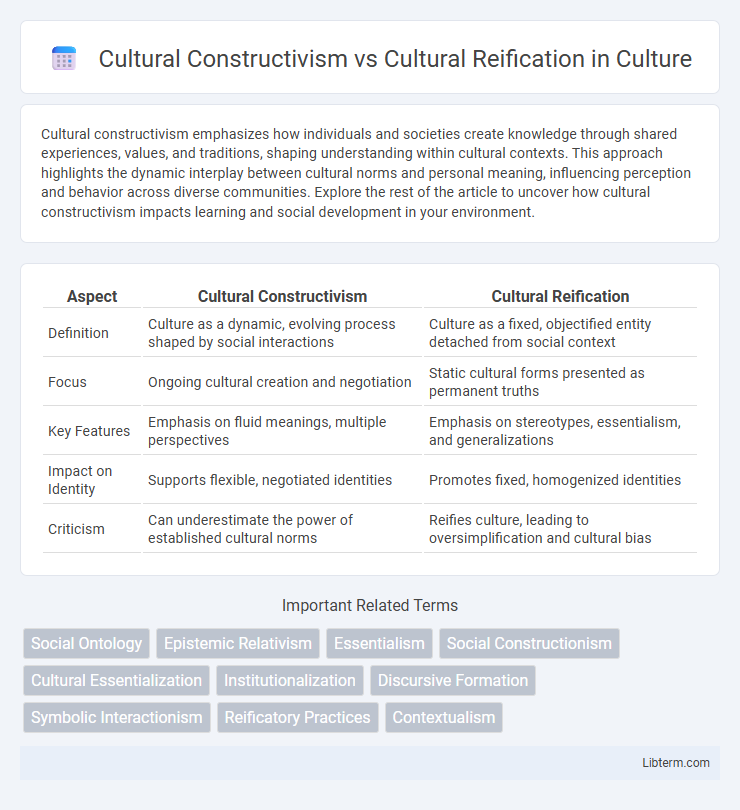Cultural constructivism emphasizes how individuals and societies create knowledge through shared experiences, values, and traditions, shaping understanding within cultural contexts. This approach highlights the dynamic interplay between cultural norms and personal meaning, influencing perception and behavior across diverse communities. Explore the rest of the article to uncover how cultural constructivism impacts learning and social development in your environment.
Table of Comparison
| Aspect | Cultural Constructivism | Cultural Reification |
|---|---|---|
| Definition | Culture as a dynamic, evolving process shaped by social interactions | Culture as a fixed, objectified entity detached from social context |
| Focus | Ongoing cultural creation and negotiation | Static cultural forms presented as permanent truths |
| Key Features | Emphasis on fluid meanings, multiple perspectives | Emphasis on stereotypes, essentialism, and generalizations |
| Impact on Identity | Supports flexible, negotiated identities | Promotes fixed, homogenized identities |
| Criticism | Can underestimate the power of established cultural norms | Reifies culture, leading to oversimplification and cultural bias |
Introduction to Cultural Constructivism and Reification
Cultural constructivism posits that social realities and cultural meanings are actively created through human interactions and shared practices, emphasizing fluidity and change within cultural contexts. In contrast, cultural reification treats these socially constructed meanings as fixed, objective entities, often solidifying norms and structures into seemingly natural or immutable forms. Understanding these concepts is essential for analyzing how cultures evolve or become rigidly institutionalized in societies.
Defining Cultural Constructivism
Cultural Constructivism defines culture as a dynamic and evolving set of social practices, beliefs, and values continuously shaped through human interaction and interpretation. It emphasizes the active role individuals and groups play in constructing and negotiating cultural meanings rather than viewing culture as a fixed or static entity. This perspective contrasts with Cultural Reification, which treats culture as a hardened, unchanging object detached from ongoing social processes.
Understanding Cultural Reification
Cultural reification involves treating culture as a fixed, static entity rather than a dynamic and evolving process shaped by social interactions and historical contexts. This concept highlights how cultural symbols, norms, and values become objectified and naturalized, obscuring their fluid and constructed nature. Understanding cultural reification reveals the limitations it imposes on interpreting cultural identity, often reinforcing stereotypes and inhibiting social change.
Historical Roots of Both Concepts
Cultural constructivism emerged from early 20th-century social anthropology and philosophy, emphasizing culture as a dynamic process shaped by human actions and interactions, rooted in the works of Clifford Geertz and Vygotsky. Cultural reification finds its origins in Marxist theory and critical sociology, particularly from Georg Lukacs, who highlighted how social relations become objectified and rigid over time, obscuring the fluid, constructed nature of culture. Both concepts trace their historical roots to debates around the nature of social reality, with constructivism stressing cultural creativity and reification focusing on the ossification and objectification of cultural phenomena.
Key Theorists and Influencers
Cultural Constructivism, championed by theorists such as Vygotsky and Bruner, emphasizes the role of social interaction and language in shaping cultural knowledge and cognitive development. In contrast, Cultural Reification, influenced by scholars like Peter Berger and Thomas Luckmann, addresses how abstract cultural concepts become concrete and institutionalized within society. These frameworks highlight the dynamic interplay between culture as a socially constructed process and culture as a fixed entity embedded in social structures.
Core Differences: Constructivism vs Reification
Cultural Constructivism views culture as a dynamic, continuously evolving process shaped by social interactions and human agency, emphasizing the subjective and negotiated nature of cultural meanings. In contrast, Cultural Reification treats culture as a fixed, objective entity, often naturalizing and solidifying cultural traits into static norms and structures detached from individual influence. The core difference lies in constructivism's focus on culture as an ongoing creation versus reification's tendency to ossify culture into unchangeable realities.
Impacts on Identity Formation
Cultural constructivism posits that identity is fluid and continually shaped through social interactions and shared meanings, emphasizing adaptability and personal agency within cultural contexts. In contrast, cultural reification treats identity as fixed and unchangeable, often reinforcing stereotypes and limiting individual expression by imposing rigid cultural categories. The divergent impacts influence how individuals perceive themselves and others, with constructivism promoting dynamic self-concepts and reification potentially leading to identity confinement and social exclusion.
Influence on Social Institutions
Cultural Constructivism views social institutions as dynamic entities shaped continuously by collective human interactions and evolving cultural meanings. Cultural Reification treats social institutions as fixed, objective realities that impose norms and behaviors on individuals through established traditions and structures. The influence on social institutions under constructivism encourages adaptability and reinterpretation, while reification reinforces stability and continuity within societal frameworks.
Critiques and Debates in Academic Discourse
Cultural constructivism emphasizes culture as a dynamic process shaped by social interactions, while cultural reification treats culture as static and fixed, leading to debates on agency and power in academic discourse. Critics argue cultural constructivism may overlook persistent structural inequalities, whereas cultural reification risks essentializing cultural groups and reinforcing stereotypes. These critiques fuel ongoing discussions on how cultural knowledge is produced, represented, and mobilized in fields like anthropology, sociology, and cultural studies.
Practical Implications for Contemporary Society
Cultural constructivism emphasizes the fluid, evolving nature of culture, encouraging contemporary societies to adapt social norms and values through dialogue and collective meaning-making processes. In contrast, cultural reification treats culture as a fixed set of traditional practices and beliefs, potentially hindering social progress and reinforcing stereotypes. Understanding these paradigms enables policymakers, educators, and community leaders to foster more inclusive, dynamic environments that reflect diverse cultural identities and drive social innovation.
Cultural Constructivism Infographic

 libterm.com
libterm.com